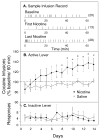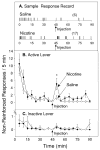Enhancement of cocaine-seeking behavior by repeated nicotine exposure in rats
- PMID: 12110995
- PMCID: PMC2587043
- DOI: 10.1007/s00213-002-1079-1
Enhancement of cocaine-seeking behavior by repeated nicotine exposure in rats
Abstract
Rationale: Drugs with addictive liability have a high probability of co-abuse in many addicts. For example, cocaine users are several times more likely to smoke cigarettes than non-cocaine users, and smoking increases during cocaine use. Previous work has provided evidence that nicotine and cocaine have interactive neurochemical effects, particularly with regard to dopamine (DA) transmission.
Objectives: The present study examined the impact of nicotine treatment on the reinforcement efficacy of self-administered cocaine and non-reinforced responding for cocaine in rats.
Methods: Rats were trained to self-administer cocaine (i.v.) on a progressive ratio (PR) schedule of reinforcement. Self-administration training continued until stable responding was obtained. Acute nicotine pretreatment consisted of a subcutaneous injection (0.15, 0.3 and 0.6 mg/kg) 3 min prior to cocaine access. In the repeated treatment condition, a separate group of animals was given nicotine (0.6 mg/kg, s.c.) 3 min prior to cocaine access for 14 consecutive days. During extinction trials, these animals were injected with nicotine (0.6 mg/kg, s.c.) after 45 min of non-reinforced responding.
Results: Acute nicotine treatment produced an inverted U-shaped dose-response function with lower doses increasing and the highest dose decreasing the number of cocaine infusions obtained during a session. Animals treated repeatedly with the highest dose of nicotine showed a significant increase in the number of cocaine infusions by day 8 of nicotine treatment. During extinction sessions when cocaine was not available, injections of nicotine in these animals caused a reinstatement of the previously rewarded lever-press behavior.
Conclusions: These findings indicate that nicotine can facilitate cocaine reinforcement, may contribute to the transition from moderate drug-taking to an escalation of drug intake which is characteristic of addiction, and may trigger relapse.
Figures





References
-
- Ahmed SH, Koob GF. Transition from moderate to excessive drug intake: change in hedonic set point. Science. 1998;282:298–300. - PubMed
-
- American Psychiatric Association. Diagnostic and statistical manual of mental disorders. 4. American Psychiatric Association; Washington, DC: 1994.
-
- Caine SB, Lintz R, Koob GF. Intravenous drug self-administration techniques in animals. In: Sahgal A, editor. Behavioral neuroscience: a practical approach. Oxford University Press; New York: 1993. pp. 117–143.
-
- Carboni E, Imperato A, Perezzani L, Di Chiara G. Amphetamine, cocaine, phencyclidine and nomifensine increase extra-cellular dopamine concentrations preferentially in the nucleus accumbens of freely moving rats. Neuroscience. 1989;28:653–661. - PubMed
-
- Childress AR, Ehrman RN, McLellan AT, O’Brien CP. Conditioned craving and arousal in cocaine addiction: a preliminary report. NIDA Res Monogr. 1988;81:74–80. - PubMed
Publication types
MeSH terms
Substances
Grants and funding
LinkOut - more resources
Full Text Sources
Medical
Research Materials

